UPDATE: Click here for Part 2 of this preview, where we’ll go over the field for the 2014 games. Also, check out our redesign of the USA Curling logo.
Opening ceremony for the 2014 Winter Olympics in Sochi, Russia is Friday night, but the real action gets started early Monday morning when the first curling matches take place. It’s time to stop talking about the Sochi toilet situation and get to some real sports.
What is Curling?
Since it’s been at least four years since you cared about curling, now’s probably a good time for refresher on the rules.
The Basics – The goal of curling is to score points by sliding curling stones (more on these later, but they’re basically 44 lb granite rocks) down a long narrow sheet of ice. Points are awarded to the team whose stones are closest to a target area or “the house”.
The Curling Sheet – The curling sheet, pictured below, is where the magic happens. Regulation curling sheets are 150 feet long and about 15 feet wide. At each end – about 114 feet part – are the targets, or houses, where the players will attempt to land their stones. There are a bunch of lines on the ice, but we’re going with the basics here, so don’t worry about it.

Gameplay – A typical curling match consists of eight or ten “ends”. During each end, the two teams take turns sliding a total of sixteen (eight per team) stones from one end of the sheet to the other, toward the target. Curlers typically crouch down, hold the stone in front of them on the ice, and push off of fixed foot holds in the ice, called “hacks”. They then must let go of the stone before its front edge crosses the “hog line” (see HOL in the diagram above). The speed, angle and rotation of the throw differ from throw to throw based on the strategy of the team and the placement of previously thrown stones in the house. Once the stone is released, two teammates slide along with the stone and use their brooms to sweep the ice in front of it. The sweeping is used to reduce friction, which can make the stone travel farther and straighter if needed. Strategies for throwing commonly include hitting opponents stones out of the house or trying to curve stones into tight areas.

Scoring – At the end of each end, the team with the stone closest to the center of the house or “button” is awarded one point for each of their stones that is closer than the opponent’s closest stone. Scoring also requires that the stone be inside the house. So, only one team is awarded points per end, and the maximum points per round would be eight (this rarely happens). The team with the highest score after all ends have been completed (or when the other team concedes) is the winner. A few scoring examples are below.
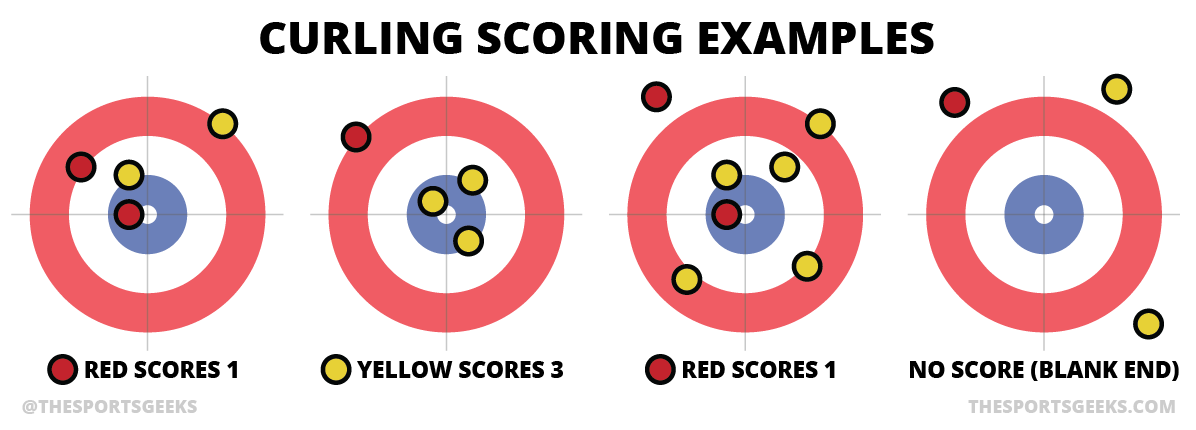
Tools of the Trade
Curling Stone – Curling stones are made of granite and weigh between 38 and 44 pounds, or about the weight of an average five-year-old. The granite for curling stones mined from either Trefor Granite Quarry in Wales or Ailsa Craig off the coast of Scotland. Right now Ailsa Craig is for sale for a mere £1,500,000, so if you’re looking to get into the curling stone business, this might be the opportunity you’ve been waiting for.
Curling Broom – Once a stone has been thrown, two sweepers slide along with it and use brooms to increase the distance of the throw and/or reduce the amount the stone curves. Curling brooms used to be made of corn strands, but they’re not anymore because it’s 2014 and we’ve come a long way.
Curling Shoes – Curlers wear one normal shoe that can grip the ice and one flat one (called a slider) to help them maneuver around the ice as needed. Sounds like fun.
Curling Pants? – Sure, why not?
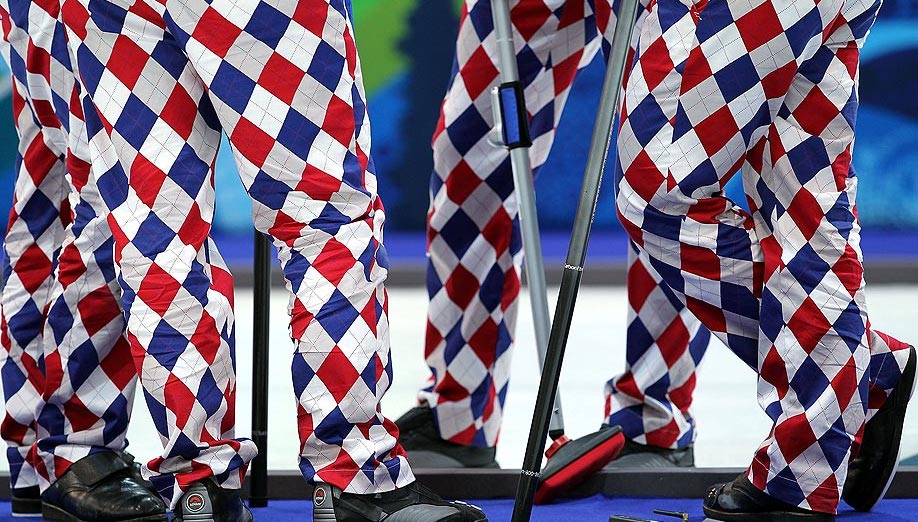
History of Curling
Nicknamed “chess on ice”, curling was invented in medieval Scotland. Curling stones have been found inscribed with dates in the 1500s and the word “curling” was first used in print in 1620. Back then, you could just grab some stones from the backyard, slide them down a frozen pond with your buddies, go for a pint and you were curling; no fancy equipment needed. Since then, curling clubs have been popping up all over and the sport has become especially popular in Canada. The World Curling Federation was established in 1961 and handles important stuff like the rules and anti-doping (and yes, there have been a few violations).
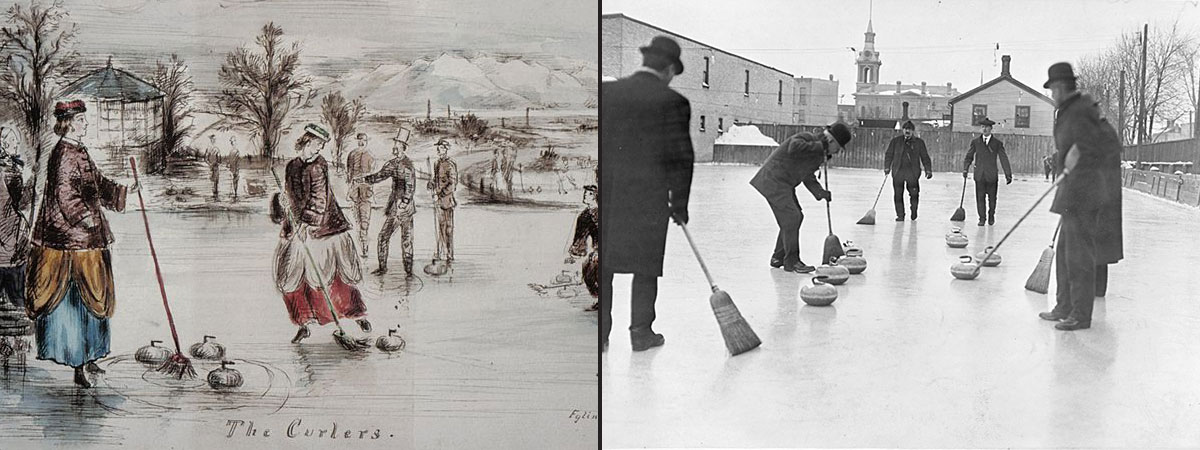
Curling might seem like one of those ancient sports that’s been in the olympics forever, but it wasn’t officially added until the 1998 Winter Olympics in Nagano, Japan (at which point they also made results of the demonstration curling at the 1924 Olympics official). Since then, the competition has been largely dominated by Canada and a bunch of Northern European countries. As you can see in the table below, us poor Americans have managed just one measly bronze medal (back in 2006).
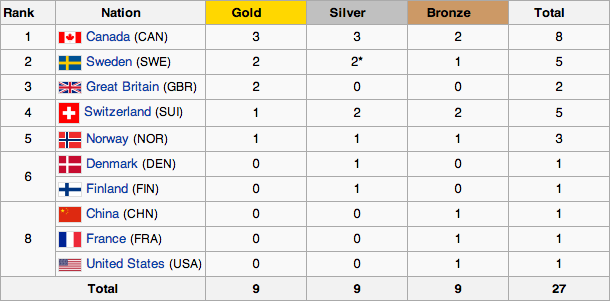
Why Is Curling Awesome?
I love curling because it’s an Olympic sport being played by a bunch of relatively-normal guys. It’s something that seems simple, but requires a ridiculous amount of skill and precision. To get you excited, here are a few videos and GIFs of some fun curling moments:
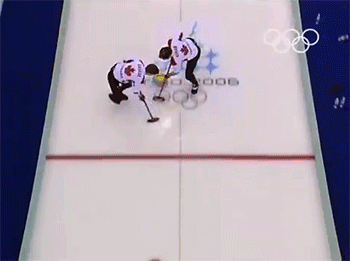
Basic/Interesting Terminology
“Biter” – A stone along the outer edge of the house whose outer edge is in the house, but is not directly making contact with the outer circle due to the shape of the stone. Biters are counted when scoring an end.
“Button” – The center of the house, in the innermost circle where the centre line and tee lines cross.
“Delivery” – The process of sliding a stone.
“End” – The division of curling matches where each team alternates throwing each of their eight stones. Curling matches generally consist of eight or ten ends.
“Eye on the Hog” – Contrary to popular belief, this has nothing to do with Bobby Petrino. It’s special handle that can be used to detect if a thrower committed a hog line violation (meaning he/she did not let go of the stone before its front edge hit the hog line).
“Hack” – Footholds that the curlers use to push off when throwing a stone. Pictured below.

“Hammer” – The hammer is the advantage of throwing the last stone on a give end. A team with the hammer is typically the one to score in a given round. Initially, the hammer is given to one team based on a coin toss or win-loss record. From that point on, the hammer belongs to the team that did not score in the previous end. If no team scores during an end, the hammer is retained by the team who had it in that end.
“House” – The target where stones are thrown at each end of the sheet.
“Skip” – The captain of a curling team.
“Snowman” or “Eight-ender” – When a team scores all eight stones in one end. Very uncommon.
If you want to know all the curling jargon, this Wikipedia page is for you.
More Curling Links
- Complete Sochi Curling Schedule – Keep in mind the time difference (-9 hours to get to EST)
- World Curling Federation – You can find a PDF with the official curling rules here amongst tons of other info like terminology.
- Curling For Dummies Cheat Sheet
- The Science of Curling (video)
- Find A Curling Club In Your Area


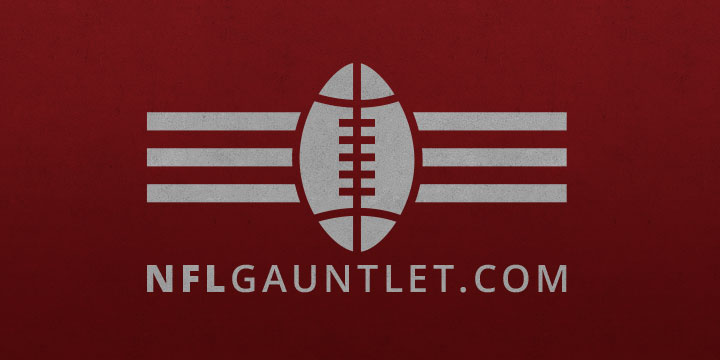

2 thoughts on “2014 Big-Ass Curling Preview: Stone Throwing 101”
Comments are closed.